Hotel interior lighting is considered one of the most important features of a hotel’s interior space. The lighting used in a hotel plays a fundamental role in conveying the atmosphere, creating a pleasant environment for guests, and enhancing their overall experience. Therefore, it is essential to ensure proper lighting in this space. In this article by Shamim Andisheh Company, the principles of hotel lighting will be examined, and its methods and key considerations will be discussed. By understanding these concepts, you can optimally light the interior of the hotel.
Hotel and Accommodation Lighting
Lighting in hotels and accommodation facilities plays a crucial role in creating a comfortable, pleasant, and welcoming atmosphere. Properly designed and implemented lighting can enhance the guest experience and showcase the identity and style of the hotel. Appropriate lighting can create a delightful, comfortable, and luxurious environment. By utilizing techniques such as layered lighting, natural light use, and decorative lights, hotels can evoke a sense of hospitality and tranquility for their guests. Adjustable lighting in rooms and public spaces also helps improve the quality of rest and well-being for guests, while smart lighting systems can contribute to energy efficiency and better light management. These principles and equipment make hotel lighting a key factor in attracting and retaining guests.
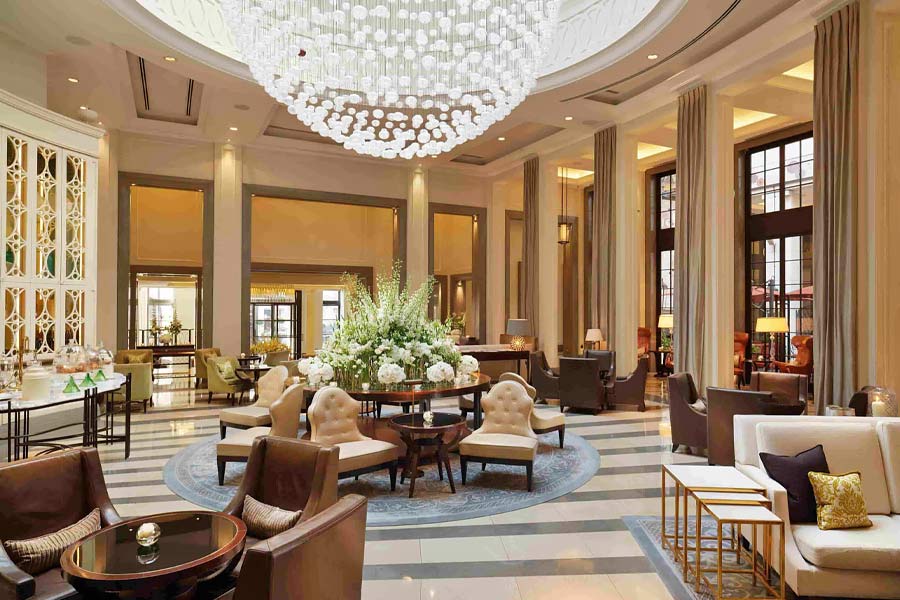
The Importance of Interior Lighting in Hotels
Interior lighting in hotels holds significant importance as it directly impacts the guest experience. Proper lighting design can transform different areas of the hotel into pleasant, relaxing, and luxurious environments. Suitable lighting not only enhances the aesthetics of the space but also boosts feelings of comfort and security.
Some reasons for the importance of interior lighting in hotels:
- Creating a Welcoming Atmosphere: Appropriate lighting in the entrance and lobby can convey a sense of hospitality and welcome to guests, leaving a positive first impression.
- Improving Comfort and Well-being: Gentle and suitable lighting in rooms can improve the quality of sleep and rest for guests. Adjustable and controlled lighting can provide an even more comfortable experience.
- Enhancing Energy Efficiency: Using high-efficiency LED lamps and smart lighting can reduce energy consumption and operational costs.
- Emphasizing Architectural and Decorative Elements: Proper lighting can highlight architectural features and interior decoration, showcasing the beauty of the spaces.
- Providing a Sense of Security: Adequate lighting in hallways and public areas ensures guests feel secure and comfortable, helping prevent unwanted incidents.
- Enhancing Visual Experience: Utilizing decorative lights and creating special lighting effects can improve guests’ visual experience, creating a unique and attractive environment.
Principles and Rules of Hotel Lighting in Various Sections
Lighting in hotels is one of the important elements of interior design that enhances the guest experience. Here are the principles and rules to be followed in lighting different sections of the hotel:
- Entrance and Lobby Lighting:
- Use of large lamps and elegant chandeliers to create a luxurious and welcoming atmosphere.
- Soft and warm lighting for walls and prominent architectural elements such as columns and the reception desk.

- Room Lighting:
- Use of adjustable lamps above the bed for reading.
- Installation of hidden lights in the ceiling and walls to create soft and relaxing lighting.
- Use of decorative lights such as lampshades and table lamps to create unique lighting effects.
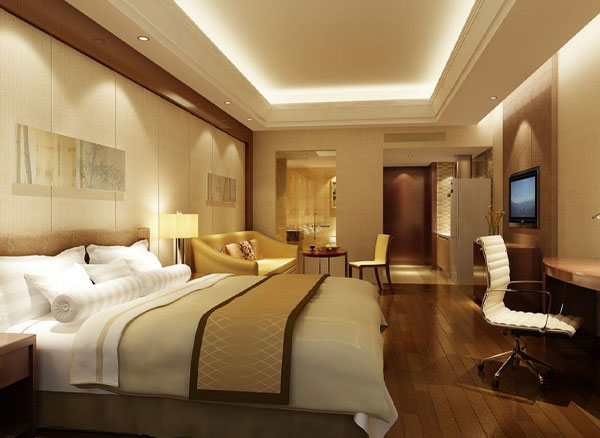
- Corridor Lighting:
- Use of wall and ceiling lights for proper illumination, along with hidden lighting in different areas to create unique lighting effects.
- Application of soft and warm lighting to foster a sense of security and comfort.
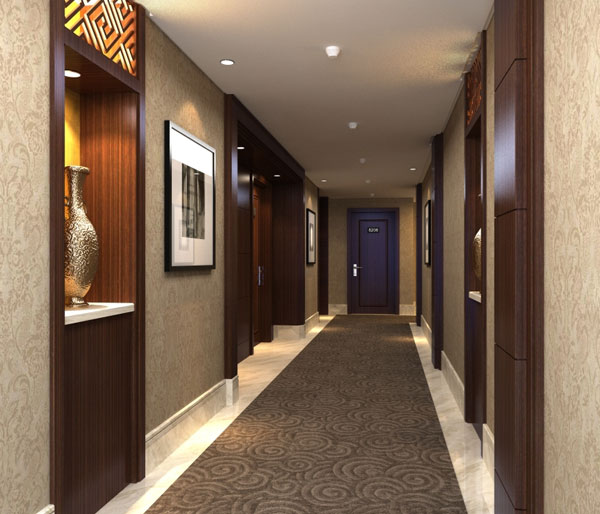
- Restaurant and Café Lighting:
- Utilizing soft and warm lighting to create a pleasant and inviting atmosphere.
- Employing table and wall lamps to focus on tables and create specific lighting points.
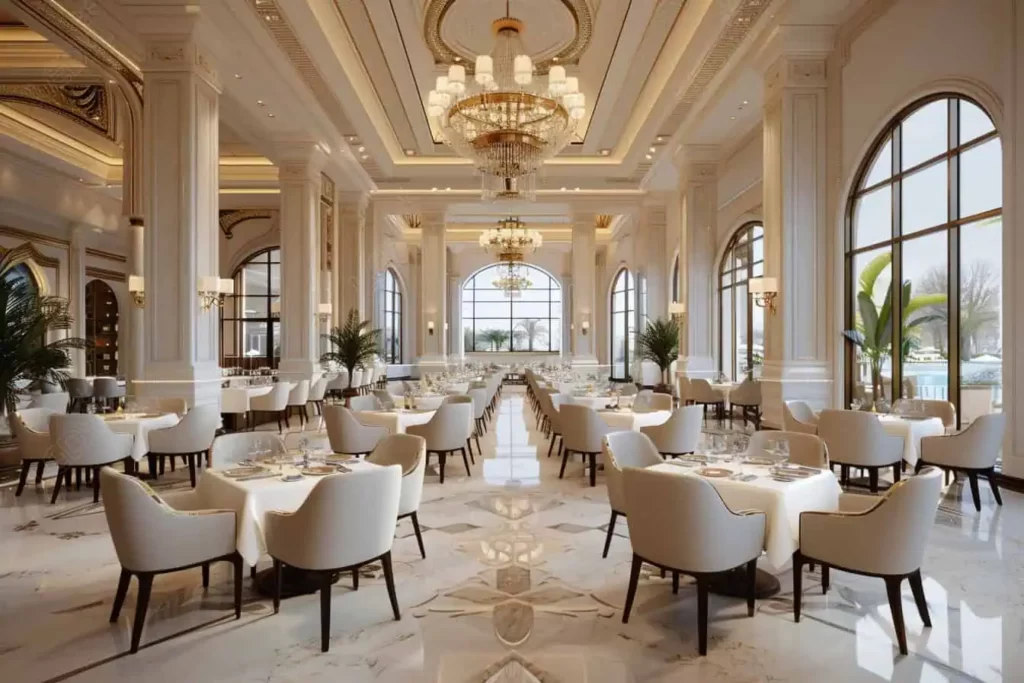
- Conference and Meeting Hall Lighting:
- Use of adjustable lighting to provide suitable illumination at different times.
- Installation of smart lighting systems for better light control and energy savings.
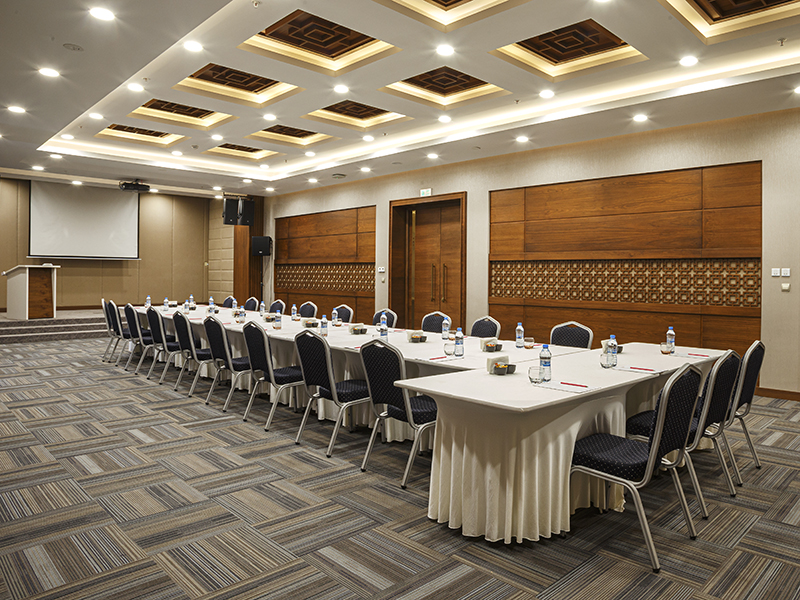
Lighting Ideas for Hotels and Accommodation Spaces
- Utilizing Natural Light: Using large windows and adjustable curtains to maximize natural light during the day.
- Layered Lighting: Employing multiple light sources at different levels to create depth and dimension in the space.
- Decorative Lighting: Incorporating decorative lights to produce attractive and unique lighting effects in the environment.
- Task Lighting: Focusing on illuminating specific areas that require more light, such as work desks, seating and reading areas, and grooming spaces.
Hotel Interior Lighting Equipment
Hotel interior lighting equipment plays a vital role in creating a pleasant, comfortable, and luxurious ambiance for guests. Choosing the right equipment and implementing proper lighting can enhance the guest experience. Below are some of the commonly used lighting equipment in hotels:
- Chandeliers and Pendant Lights:
- Chandeliers: Used to create an elegant and sophisticated effect in lobbies, restaurants, and meeting halls.
- Pendant Lights: Suitable for areas like restaurants and living rooms, where soft and decorative lighting is needed.
- Wall Lights:
- Wall Lights: Used for general lighting and highlighting architectural elements such as paintings and mirrors.
- Hidden Wall Lights: Employed to create unique lighting effects and concealed lighting within walls.
- Table Lamps and Lampshades:
- Table Lamps: Used for work and study desks in guest rooms.
- Lampshades: Placed beside beds and bedside tables for soft and decorative lighting.
- Ceiling Lights:
- Recessed Lights: Provide general illumination in various hotel spaces such as corridors, lobbies, and rooms.
- Hidden Ceiling Lights: Suitable for soft and concealed ceiling lighting.
- LED Lighting:
- LED Strip Lighting: Creates unique lighting effects in various spaces such as ceilings, walls, and corridors.
- LED Bulbs: Used throughout the hotel to reduce energy consumption and enhance lighting efficiency.
- Smart Lighting Systems:
- Light Control Systems: Used to manage and adjust lighting in different hotel spaces. These systems help save energy and create suitable lighting conditions.

 English
English العربية
العربية

















